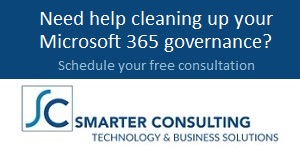Content Strategy: Protecting the Brand Without Slowing It to a Crawl
In the rush to publish, brands often forget that one risky sentence, an overlooked image license, or an ambiguous AI disclosure can trigger a legal nightmare. The goal of editorial governance isn’t to bog down your content team. It’s to protect your brand’s integrity while keeping the wheels turning.
 Whether you’re a solo creator, small business, or global enterprise, the risks are real and often avoidable with the right checks in place. In this latest post in my ongoing Content Strategy series, I’ll break down editorial governance strategies that apply across the spectrum, with tips tailored for every size of team.
Whether you’re a solo creator, small business, or global enterprise, the risks are real and often avoidable with the right checks in place. In this latest post in my ongoing Content Strategy series, I’ll break down editorial governance strategies that apply across the spectrum, with tips tailored for every size of team.
1. Define Legal and Compliance Triggers (and “Pre-Approved” Zones)
Not all content carries the same level of risk. Define which topics, claims, or industries trigger legal or compliance reviews—financial advice, health claims, government references, or anything touching on PII should automatically raise a flag.
For Enterprises: Create a review matrix across teams, with defined roles for legal, compliance, and brand.
For SMBs: Develop a simple list of “needs review” topics and pre-cleared formats. Avoid bottlenecks by enabling faster reviews on recurring, low-risk content.
For Individuals: Keep a running doc of red-flag words or topics. If you’re unsure, don’t post until you’ve reviewed the source or language.
Also, create “pre-approved” zones—topics, templates, and formats that have already been cleared for publication without additional oversight. These shortcuts give teams of all sizes the ability to move faster without ignoring risk.
2. Document AI Use, Disclosure Policies, and Watermarking Rules
As AI-generated content becomes more common, disclosure is not just ethical—it’s soon to be regulatory. Clearly document how and when AI is used, whether for ideation, image generation, or full-text drafting. Decide on a watermarking standard for visual assets and set expectations for when disclosures should appear.
For Enterprises & SMBs: Draft a formal AI disclosure policy. If using AI-generated visuals, establish rules for captions or visual watermarks.
For Solo Creators: Add a line to your About page or blog footer about your use of AI. For AI images, watermark or indicate source in a caption. This builds trust—and protects you from future scrutiny.
3. Maintain a Licensed Asset Registry
This one is rapidly becoming important to those using AI to help create, edit, and publish content. Unlicensed images, music, fonts, or user-generated content (UGC) are low-hanging fruit for copyright violations. Centralize all approved assets—include usage rights, expiration dates, and source attribution.
For Enterprises: Use a DAM (Digital Asset Management) system with tagging, usage rights, and expirations.
For SMBs: A shared OneDrive, Dropbox, or Google Drive folder with licenses in subfolders may be enough, as long as it’s organized.
For Individuals: Keep a simple spreadsheet or use folders in tools like Canva or Adobe Cloud. If you grabbed it from Google Images, don’t use it without proper attribution.
Always assume that a screenshot of a competitor’s app, an image from a random blog, or a trending TikTok sound is not automatically legal to repost or reuse.
4. Create a Pre-Publish Checklist
Before anything goes live, your editors—or you—should tick off a list that covers:
- Claims and substantiation (Are we saying anything that requires proof?)
- Personally Identifiable Information (PII)
- Trademark references
- Third-party screenshots or quotes
- AI disclosures
For Enterprises: Automate this checklist into your CMS workflow.
For SMBs and Individuals: Print it out, add it to Microsoft Teams, or make it part of your content template. It’s 5 minutes that could save you a lawsuit.
5. Train Editors (and Yourself) on Boundary Areas
Don’t assume that people automatically understand where the legal lines are—especially when it comes to health, finance, and defamation.
For Enterprises: Run regular training for legal, brand, and content teams. Include regulatory trends, especially in AI.
For SMBs: A quarterly lunch-and-learn with real examples is more than enough. Or send out a “what not to do” roundup.
For Individuals: Follow trusted legal creators. Read platform terms. When in doubt, Google the boundaries of your niche.
Even if you’re a solo operator, if you outsource writing, video editing, or VA tasks—make sure your freelancers know your boundaries too.
6. Keep an Incident Response Playbook
Mistakes happen. A tweet goes viral for the wrong reason, or a blog post includes a sketchy claim. When it does, the worst thing you can do is scramble.
For Enterprises: Your playbook should include:
- Legal notification workflows
- Customer service scripting
- Public-facing apology/revision plans
- Internal comms coordination
For SMBs: Designate a single person (or two-person team) to handle incidents, review facts, and issue takedowns or edits.
For Individuals: Keep a mini-plan:
- Pause posting
- Delete or revise the content
- Issue a clarification if needed
- Reflect and refine your process
Post-mortems aren’t just for big companies. One viral post gone wrong can tank your brand’s credibility. Learn, revise, and move on.
Governance Isn’t Bureaucracy—It’s Guardrails
Editorial governance isn’t about creating bottlenecks. It’s about building fast, safe lanes for publishing content at scale. Enterprises need automation and cross-team clarity. SMBs need just enough structure to avoid chaos. Individuals need a checklist and a little foresight.
No matter what size the organization, the goal is the same: protect your brand’s credibility without slowing down your momentum. When your editorial safety net is clear, concise, and right-sized to your team, everyone wins—especially your audience.




